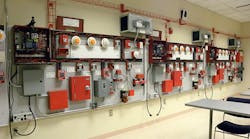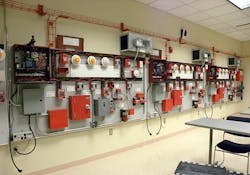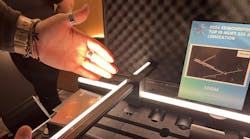We all know electrical workers are responsible for installing many different electrical systems within a building (lighting and receptacles). But what about all of the other types of systems, such as building automation, security, access control, network, and life safety? Electrical contractors can install these, too. However, when it comes to the installation and maintenance of fire alarm systems, specific training is a must.
Because fire alarm systems support a life safety function that is crucial to the occupants of a building, such as those occupied by the general public (e.g., public and private schools, office buildings, theaters, shopping centers, churches), the functionality and reliability of these systems could mean the difference between life and death. For this very reason, it’s crucial that electrical professionals performing this type of work are trained and competent in installation and maintenance of fire alarm systems.
What type of training is actually needed?
Article 760 of the NEC focuses on the installation of wiring and equipment of fire alarm systems. However, there are many other codes and standards you must follow when installing these systems, including the NFPA Fire Alarm and Signaling Code (NFPA 72), International Building Code (IBC), Life Safety Code (NFPA 101), International Fire Code (IFC), and Americans with Disabilities Act (ADA).
Electrical workers must understand and know how to apply these codes and standards to ensure the fire alarm installation meets at least the minimum code requirements. With that said, every training program must make sure all of these codes and standards are included within its framework, especially those that train apprentices.
In addition to adhering to codes and standards, the electrical worker must have a fundamental understating of how a fire alarm system operates. This includes, but is not limited to, the theory of operation of the fire alarm control panel, operation of initiating devices, operation of notification devices, and special circumstances that may arise during the installation. All of these topics should be included in the fire alarm curriculum provided to the electrical apprentice.
After the apprentice understands the code and theory behind a fire alarm installation, he or she must understand the applicable installation and maintenance requirements of the installation. This requires the electrical worker to understand the numerous technologies involved in the fire alarm industry. With that very concept in mind, the fire alarm curriculum used for fire alarm training should focus on technologies of the past as well as those currently being used today.
Why would this be important? Because electrical workers must be able to service and maintain all types of systems. Past fire alarm technologies were typically separated into logical zones, such as a single floor of a building. This technology has proven very reliable; however, identifying which device triggered a single alarm proved to be difficult. Newer fire alarm technologies incorporate intelligent devices that periodically report the device status to the fire alarm control panel. In addition, newer technologies provide the ability to program specific information about the devices that are installed, such as the exact location of the device.
Although intelligent fire alarm systems are the most common systems installed today, there are still many zone-type fire alarm systems found in buildings around the country. Electrical professionals must be ready for either arrangement.
Troubleshooting and maintenance
There are many things that can go wrong during a fire alarm installation. Whether it’s a conductor getting pinched between the device and the box it is mounted to (causing a ground fault condition) or a conductor getting cut by another construction worker (creating an open condition), electrical workers must have the ability to identify where the problem exists and how to correct it. The ability to address the problems (whether the installation is a new installation or an existing system) will invariably separate the men from the boys, so to speak. Therefore, it is imperative that all fire alarm training courses and programs identify the proper procedures that are needed to effectively troubleshoot fire alarm system problems.
Achieving certification
NFPA 72 requires fire alarm installers to be qualified in order to install a fire alarm system. In fact, there are many specifications that now require a third-party fire alarm certification. Unfortunately, many electrical workers who have been installing fire alarm systems for many years do not possess a third-party certification. Even though many electrical workers may be qualified to install a fire alarm system because of on-the-job experience, they may still be required to obtain a third-party certification. This can be accomplished through in-class fire alarm system training or by leveraging online practice exams like those now available to IBEW/NECA members. These practice examinations have been created to simulate the two most common third-party certification exams.
Simpson is a curriculum specialist with the National Joint Apprenticeship and Training Committee (NJATC) based in Upper Marlboro, Md. The NJATC is the training arm of the International Brotherhood of Electrical Workers and the National Electrical Contractors Association. He can be reached at [email protected].
SIDEBAR: The Hands-On Training Difference
Nothing hits the point home better than real-world experience. This is best accomplished with on-the-job experience under direct supervision. Although there is no doubt that hands-on experience trumps what can be accomplished in a lab environment, there are many training facilities around the country that have taken the lab experience to a new level. For example, the NJATC has developed a lab manual that applies real-life fire alarm installation in a controlled environment, which allows electrical workers to apply theory, installation, and troubleshooting concepts in a truly interactive and safe environment that encourages a systematic approach to solving problems.
For instance, a lab may require the installer to simulate a high-rise office building that requires complex programming and integration with other electrical systems. Another may simply require that the fire alarm system closes an HVAC damper. Both examples are real-life installations that provide the electrical worker with practical experience in a controlled environment. Another lab may require the electrical worker to diagnose or troubleshoot a problem that exists with the installation.
Without a doubt, students will make mistakes while going through the lab experience. However, it is better to make those mistakes in a controlled lab environment — where the instructor can point out issues and offer advice on corrective actions — as opposed to making them in a stressful job-site situation. Sure, mistakes in the lab may cause a little frustration, but mistakes on the job could cost the contractor money, delay the project, or possibly create a life safety concern.




